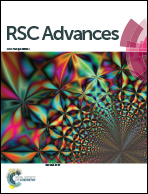Ultrathin graphene-based solar cells†
Abstract
Ultrathin solar cells (USC) have the potential to provide ubiquitous, cheap, and efficient sources of energy. Practical issues, however, prevent the formation of solar cells below 100 nm. Cracks, voids, and inhomogeneities result in leakage pathways that render ultrathin solar cells unusable. We here demonstrate the use of graphene as the top electrode for ultrathin solar cells. Graphene was shown to suspend over pinholes in the active layer and enable current leakage–current-free carrier transport even for ultrathin semiconductor films. This advantage enabled the fabrication of solid-state dye-sensitized solar cells with TiO2 thicknesses between 5 nm and 100 nm, which represents some of the thinnest solar cells produced to date. The produced ultrathin USCs exhibit a unique dye-loading characteristic that was attributed to the quasi two-dimensional nature of the TiO2 film. Carrier recombination was found to be significantly enhanced in these thin films which limits the performance for increasing TiO2 thicknesses. Finally, charge compensation of the photoexcited dye poses limitations on the minimum thickness of the TiO2 which was found to be 10 nm. This work highlights the limits of USC scaling and opens up a new route to producing ultrathin solar cells for transparent and flexible applications.


 Please wait while we load your content...
Please wait while we load your content...